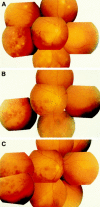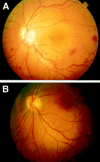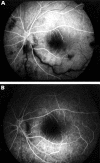Treatment of ocular symptoms of Behçet's disease with interferon alpha 2a: a pilot study
- PMID: 9713053
- PMCID: PMC1722610
- DOI: 10.1136/bjo.82.5.488
Treatment of ocular symptoms of Behçet's disease with interferon alpha 2a: a pilot study
Abstract
Aim: To study long term effects of interferon alpha 2a (IFN alpha 2a) on panuveitis in seven patients with Behçet's disease in a prospective, open clinical trial.
Methods: Seven patients were treated with IFN alpha 2a for a mean of 23.6 months (14-37 months). They received an initial dose of IFN alpha 2a of 6 x 10(6) IU/day, followed by 3 x 10(6) IU/day after 1 month and 3 x 10(6) IU every other day after 3 months. Two patients received low dose prednisolone (between 0.2 and 0.4 mg/kg/body weight) additionally at the beginning of the therapy. Complete cessation of IFN alpha 2a was possible in three patients (observation period 22, 6, and 4 months).
Results: Marked improvement occurred in six patients who had ocular manifestations of Behçet's disease for the first time or with minor damage during their course of chronic relapsing panuveitis. In one patient with advanced ocular Behçet's disease, new relapses were prevented. Retinal infiltrates resolved within 2 weeks; vasculitis, macular oedema, infiltration of the anterior chamber and vitreous resolved within 4 weeks. Mean posterior uveitis score before treatment (nine affected eyes) was 6.6, 4 weeks after IFN it was reduced to 0.4. The mean observation period is 27.6 months, ranging from 14 to 42 months.
Conclusion: Treatment of ocular symptoms of Behçet's disease with IFN alpha 2a alone or in combination with low dose steroids led to complete remission of ocular vasculitis in all patients treated in this open, uncontrolled trial. Treatment with IFN alpha 2a may prevent permanent retinal or optic nerve damage due to vascular occlusion. No severe side effects occurred. Controlled randomised studies are warranted in order to prove the efficacy of IFN alpha 2a in ocular Behçet's disease and to compare it with other, established treatments such as azathioprine or cyclosporin A.
Figures



Similar articles
-
Human recombinant interferon alfa-2a for the treatment of Behçet's disease with sight threatening posterior or panuveitis.Br J Ophthalmol. 2003 Apr;87(4):423-31. doi: 10.1136/bjo.87.4.423. Br J Ophthalmol. 2003. PMID: 12642304 Free PMC article.
-
Longterm visual prognosis of patients with ocular Adamantiades-Behçet's disease treated with interferon-alpha-2a.J Rheumatol. 2008 May;35(5):896-903. Epub 2008 Apr 15. J Rheumatol. 2008. PMID: 18412306
-
[Behçet's disease: uveitis-therapy with interferon alpha2a - prospective clinical study in 33 patients].Klin Monbl Augenheilkd. 2001 Dec;218(12):768-73. doi: 10.1055/s-2001-19687. Klin Monbl Augenheilkd. 2001. PMID: 11805868 German.
-
[Ocular manifestations in Behçet's disease].Rev Med Interne. 2018 Sep;39(9):738-745. doi: 10.1016/j.revmed.2018.02.022. Epub 2018 Apr 4. Rev Med Interne. 2018. PMID: 29625716 Review. French.
-
[Panuveitis with oral and genital ulcer misdiagnosed as Behcet's disease: two cases report and literature review].Beijing Da Xue Xue Bao Yi Xue Ban. 2016 Oct 18;48(5):910-914. Beijing Da Xue Xue Bao Yi Xue Ban. 2016. PMID: 27752180 Review. Chinese.
Cited by
-
AAV2-mediated combined subretinal delivery of IFN-α and IL-4 reduces the severity of experimental autoimmune uveoretinitis.PLoS One. 2012;7(6):e37995. doi: 10.1371/journal.pone.0037995. Epub 2012 Jun 7. PLoS One. 2012. PMID: 22685550 Free PMC article.
-
[Ocular involvement in Behçet's disease: first 5-year-results for visual development after treatment with interferon alfa-2a].Ophthalmologe. 2004 Feb;101(2):129-34. doi: 10.1007/s00347-003-0927-7. Ophthalmologe. 2004. PMID: 14991308 German.
-
Behçet's disease: recent advances in early diagnosis and effective treatment.Curr Rheumatol Rep. 2008 Oct;10(5):349-55. doi: 10.1007/s11926-008-0057-y. Curr Rheumatol Rep. 2008. PMID: 18817637 Review.
-
Update in treatment of uveitic macular edema.Drug Des Devel Ther. 2019 Feb 19;13:667-680. doi: 10.2147/DDDT.S166092. eCollection 2019. Drug Des Devel Ther. 2019. PMID: 30858697 Free PMC article. Review.
-
Behçet's Disease.Curr Treat Options Neurol. 2011 Jun;13(3):290-310. doi: 10.1007/s11940-011-0120-2. Curr Treat Options Neurol. 2011. PMID: 21416331
References
Publication types
MeSH terms
Substances
LinkOut - more resources
Full Text Sources
Medical
